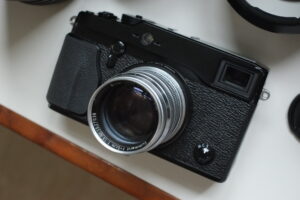The X-Pro1 in 2025 — Still My Quiet Workhorse
Self-portrait (I’m in the sliver in the centre of the revolving door, right where the arrows are pointing) shot with x-Pro1 and XF14mm f/2.8.
The ISO was 200. I slowed the shutter to 1/17s so that I can get motion blur on the lady. Being set on AE priority, the computer inside X-Pro1 worked out the aperture to be f/11.
I know what you’re thinking: Why are we still talking about the Fujifilm X-Pro1 in 2025? After all, it came out over a decade ago. In tech years, that’s basically ancient. But here I am, still reaching for it — not out of nostalgia (well, maybe a little), but because it still delivers.
[Edit: alas I sold it recently, and now I find myself grasping at empty air where my X-Pro1 used to be]
The X-Pro1 was never about speed or specs. It was about feeling. About slowing down and seeing differently. That hybrid optical/electronic viewfinder? Still one of the most satisfying ways to frame a shot. There’s something incredibly grounding about composing through glass instead of a screen — a connection to the scene that’s almost tactile.
The sensor — that 16.3MP X-Trans CMOS — might seem modest now, but it’s got this organic character to it. Paired with Fuji’s film simulations (hello, Classic Chrome and Acros), the files have a richness that doesn’t feel overly clinical. It’s not the sharpest tool in the shed by today’s standards, but honestly? I’m not always chasing sharp. I’m chasing mood.
In 2025, this camera still holds up surprisingly well:
-
APS-C X-Trans sensor with no optical low-pass filter = clean detail, beautiful tones
-
Hybrid OVF/EVF = best of both worlds when you want to slow down or shoot fast
-
Compact body = perfect for travel, street,
-
and anywhere I want to be invisible
-
Manual dials = because clicking a shutter speed ring just feels better than tapping a touchscreen
-
Battery life… okay, still terrible, but I carry two spares and make peace with it
Is it slow? Yeah. The autofocus hunts in low light. Startup time is leisurely. And no, it doesn’t shoot 4K, burst like a sports cam, or connect seamlessly to your phone. But it also doesn’t get in the way. It doesn’t beg to be updated. It just… works. Quietly. Reliably. Like an old friend who doesn’t say much, but always shows up when it matters.
I’ve brought the X-Pro1 to some of the most remote places — salt flats in Bolivia, rainy mountaintops, chaotic cities — and it has never failed to bring home images I love. Maybe it’s not a camera for every job anymore, but for the kind of thoughtful, deliberate photography I’m doing these days, it’s enough. More than enough.
In a world of ever-refreshing gear cycles and megapixel wars, the X-Pro1 is a reminder that sometimes, the best camera isn’t the newest. It’s the one that makes you want to pick it up and shoot.
